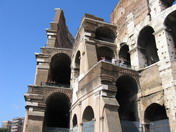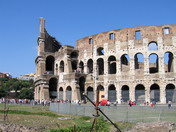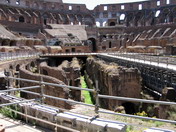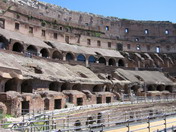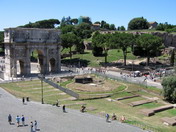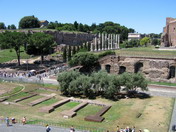Colosseum - Rome
The "bread and circuses" at the Colosseum in Rome was a way for the emperor of Rome ti distracted the people While they rolled themselves in money and wealth by sucking out the population.
In the stadium/arena that held 55,000 spectators, it was possible to see everything from gladiator games and theater to the killings and fights between wild animals. Several prisoners of war, criminals and slaves lost their lives to entertain the audience that shouted, "There he was!" (Habet!) when someone was killed. Those who escaped the fighting but had struggled badly risked yet to lose his life. It was enough that the Emperor chose to do the thumbs down.
(Click the images of Colosseum for larger versions)
Although the Colosseum is in poor condition, it is still one of the most impressive sights or attraction in Rome.
Outside the Colosseum, you can be photographed with the gladiators.Most people think it's a nice gesture towards tourists but afterwards the gladiator wants to get paid otherwise get grouchy. One trick which is also widely used elsewhere.
Do not accept anything that seems free if you are not prepared to pay.
On the other hand, we did not see so many beggars in Rome.
This side of the Colosseum is in much worse shape.
Outside the stadium an old woman was begging with bowed head, dressed in a worn coat with a large hood. The hood hid her face completely but we noticed that she was wearing a cople of expensive running shoes from Nike..The "Lady" was probably not quite as old as she wanted to give the impression and far from as poor...
Map of Colosseum »
Colosseum, history and facts:
The construction of the Colosseum (Colosseo) in Rome started 72 AD by Vespanius and inaugurated with great fanfare by his son Emperor Titus 80 AD. The emperor Domitian was the one who completed the construction. Opening ceremony lasted for hundred days and it is believed that about 9000 animals (including four elephants) and 2000 gladiators were killed during the event. It ended with the emperor filled Colosseum with water and then let the horses and bulls swim around while gladiators in boats fought a battle.
The name Colosseum comes from the colossal statue of Emperor Nero that stood next to the site where the stadium was built. The official name is The flavian amphitheater (Amphiteatrum Flavium).
Colosseum is 524 meters in circumference and 48 feet high. It is 79 meters long and 46 meters wide. It held 55,000 spectators. The stadium's floors were covered in sand (= rena, thence also called a-rena).
At the crest of the arena there were apparatus for tensioning a fabric "velariet" which was used to protect the public against the burning sun. The task of managing velariet entrusted sailors in the Imperial Navy. It was a complicated and ingenious device which consisted of several blocks, tackles and ropes in addition to the fabric obscuring the sun and all the banners that adorned the venue.
The cloth was a clever device to increase comfort. Of course, I marvel that the bloodthirsty crowd could not stand some sun while they were expected to see gladiators and animals kill each other in the arena...
The entrances to the Colosseum was numbered so spectators of different social status in Rome would find their proper place. The emperor of course had his own entrance.
One of the entrances to the arena was used to carry out the dead gladiators and animals. Another was used for gladiators and their entourage as they entered the arena. When they past the Emperor the shouted:
"Hail, Caesar, for those about to die we salute you!" (Ave Caesar, Morituri te salutant!) I doubt that the custom arose spontaneously ...
The statue of Nero no longer exists,it was melted down to make weapons. Even the Colosseum suffered since they used the reinforcement for weapons, which in turn led to that large parts of the facade collapsed in an earthquake. Colosseum also was "robbed" by big quantities of white marble that then was used to build St Peter's Basilica and Fontana di Trevi.
Colosseum is a great arena to visit when in Rome but it represents a "low point" in human history. People and animals had to killed each other just to amuse the crowd...


